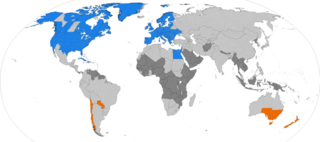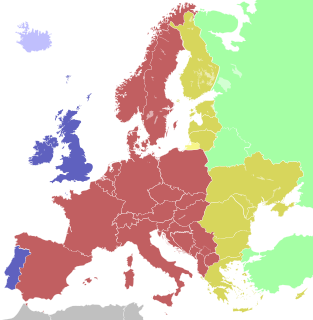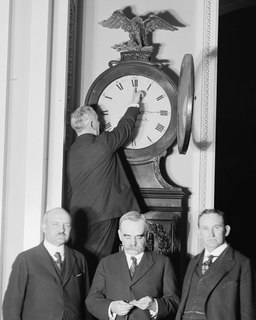
Daylight saving time (DST), also known as daylight savings time or daylight time, and summer time, is the practice of advancing clocks during warmer months so that darkness falls at a later clock time. The typical implementation of DST is to set clocks forward by one hour in the spring and set clocks back by one hour in autumn to return to standard time. As a result, there is one 23-hour day in late winter or early spring and one 25-hour day in the autumn.

Western European Summer Time is a summer daylight saving time scheme, 1 hour ahead of Greenwich Mean Time and Coordinated Universal Time. It is used in:

Japan Standard Time, or Japan Central Standard Time, is the standard time zone in Japan, 9 hours ahead of UTC. There is no daylight saving time, though its introduction has been debated several times. During World War II, it was often called Tokyo Standard Time.

The North American Central Time Zone (CT) is a time zone in parts of Canada, the United States, Mexico, Central America, some Caribbean Islands, and part of the Eastern Pacific Ocean.

The Eastern Time Zone (ET) is a time zone encompassing part or all of 23 states in the eastern part of the United States, parts of eastern Canada, the state of Quintana Roo in Mexico, Panama and Colombia, mainland Ecuador, Peru, and a small portion of westernmost Brazil in South America, along with certain Caribbean and Atlantic islands.

The Mountain Time Zone of North America keeps time by subtracting seven hours from Coordinated Universal Time (UTC) when standard time (UTC−07:00) is in effect, and by subtracting six hours during daylight saving time (UTC−06:00). The clock time in this zone is based on the mean solar time at the 105th meridian west of the Greenwich Observatory. In the United States, the exact specification for the location of time zones and the dividing lines between zones is set forth in the Code of Federal Regulations at 49 CFR 71.

Time in the United States, by law, is divided into nine standard time zones covering the states, territories and other US possessions, with most of the United States observing daylight saving time (DST) for approximately the spring, summer, and fall months. The time zone boundaries and DST observance are regulated by the Department of Transportation. Official and highly precise timekeeping services (clocks) are provided by two federal agencies: the National Institute of Standards and Technology (NIST) ; and the United States Naval Observatory (USNO). The clocks run by these services are kept synchronized with each other as well as with those of other international timekeeping organizations.

Central European Summer Time (CEST), sometimes referred to as Central European Daylight Time (CEDT), is the standard clock time observed during the period of summer daylight-saving in those European countries which observe Central European Time during the other part of the year. It corresponds to UTC+02:00, which makes it the same as Eastern European Time, Central Africa Time, South African Standard Time, Egypt Standard Time and Kaliningrad Time in Russia.
Time in New Zealand is divided by law into two standard time zones. The main islands use New Zealand Standard Time (NZST), 12 hours in advance of Coordinated Universal Time (UTC) / military M (Mike), while the outlying Chatham Islands use Chatham Standard Time (CHAST), 12 hours 45 minutes in advance of UTC / military M^ (Mike-Three).

The Atlantic Time Zone is a geographical region that keeps standard time—called Atlantic Standard Time (AST)—by subtracting four hours from Coordinated Universal Time (UTC), resulting in UTC−04:00. During part of the year, some portions of the zone observe daylight saving time, referred to as Atlantic Daylight Time (ADT), by moving their clocks forward one hour to result in UTC−03:00. The clock time in this zone is based on the mean solar time of the 60th meridian west of the Greenwich Observatory.

The Newfoundland Time Zone (NT) is a geographic region that keeps time by subtracting 3+1⁄2 hours from Coordinated Universal Time (UTC) during standard time, resulting in UTC−03:30; or subtracting 2+1⁄2 hours during daylight saving time. The clock time in this zone is based on the mean solar time of the meridian 52 degrees and 30 arcminutes west of the Greenwich Observatory. It is observed solely in the Canadian province of Newfoundland and Labrador.

UTC−04:00 is an identifier for a time offset from UTC of −04:00. It is observed in the Eastern Time Zone during the warm months of daylight saving time, as Eastern Daylight Time. The Atlantic Time Zone observes it during standard time . It is observed all year in the Eastern Caribbean and several South American countries.

Australia uses three main time zones: Australian Western Standard Time, Australian Central Standard Time, and Australian Eastern Standard Time. Time is regulated by the individual state governments, some of which observe daylight saving time (DST). Australia's external territories observe different time zones.

The Canadian province of Saskatchewan is geographically located in the Mountain Time Zone (GMT−07:00). However, most of the province observes Central Standard Time (CST) (GMT−06:00) year-round. As a result, it is effectively on daylight saving time (DST) year-round, as clocks are not turned back an hour in autumn when most jurisdictions return to standard time.

Mexico uses four main time zones since February 2015. Most of the country observes Daylight Saving Time (DST).
- Zona Sureste covers the state of Quintana Roo is UTC-05:00 year round. It is the equivalent of U.S. Eastern Standard Time.
- Zona Centro covers the eastern three-fourths of Mexico, including Mexico City, Guadalajara, and Monterrey. For most of the year, it is the equivalent of U.S. Central Time.
- Zona Pacífico covers the states of Baja California Sur, Chihuahua, Nayarit, Sinaloa, and Sonora. For most of the year, it is the equivalent of U.S. Mountain Time. The state of Sonora, like the U.S. state of Arizona, does not observe DST.
- Zona Noroeste covers the state of Baja California. It is identical to U.S. Pacific Time, including the DST schedule.

Daylight saving time in the United States is the practice of setting the clock forward by one hour when there is longer daylight during the day, so that evenings have more daylight and mornings have less. Most areas of the United States and Canada observe daylight saving time (DST), the exceptions being Arizona, Hawaii, and the overseas territories of American Samoa, Guam, the Northern Mariana Islands, Puerto Rico, and the United States Virgin Islands. The Uniform Time Act of 1966 established the system of uniform daylight saving time throughout the US.
Daylight saving time (DST) is currently observed in nine of ten provinces and two of three territories in Canada, but with exceptions in several provinces and Nunavut. Most of the province of Saskatchewan, despite geographically being in the Mountain Time Zone, observes year-round Central Standard Time (CST). In 2020, the territory of Yukon abandoned seasonal time change to permanently observe year-round Mountain Standard Time (MST). Under the Canadian Constitution, laws related to timekeeping are a provincial or territorial matter.
Daylight saving time in the Americas is the arrangement in the Americas by which clocks are advanced by one hour in spring and moved back in autumn, to make the most of seasonal daylight. The practice is widespread in North America, with most of Canada, Mexico, and the United States of America participating, but much less so in South America.

Daylight saving time (DST), also known as summer time, is the practice of advancing clocks during part of the year, typically by one hour around spring and summer, so that daylight ends at a later time of the day. As of 2021, DST is observed in most of Europe, most of North America and parts of Asia around the Northern Hemisphere summer, and in parts of South America and Oceania around the Southern Hemisphere summer. It was also formerly observed in other areas.
The United States Virgin Islands use the Atlantic Time Zone with no daylight saving time, due to how close it is to the equator. This is also true in Puerto Rico.








